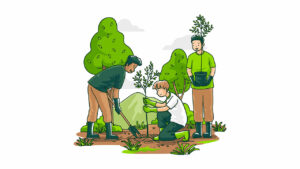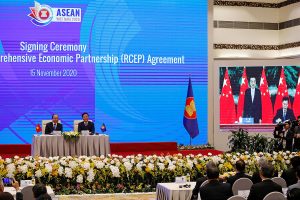Tree Planting 4.0 for executives

Probably the most popular employee engagement volunteer activity is Tree Planting. But has this really helped? Do the trees grow to be century-old trees, like those we see in New Manila, UP Diliman, and in the UP Los Baños Forestry areas? Or are we just doing lip service, or hand service in this case?
Before an employee engagement activity, Human Resource (HR) managers should learn a thing or two about planting trees, especially those interested in coffee, coconut, and maybe even mangroves. Thanks to GCash and GForest, its latest app feature, we are introduced to different species of trees needing replanting, reforestation, and conservation.
1. Choose the right variety or species. Make sure the seedlings are indigenous to our forests, and not introduced varieties.
2. Get a lesson or two in tree planting basics. Remove the plastic bag before setting the tree in place in a hole with the correct size appropriate for the species.
3. Know about basal fertilizers and quality of soil.
4. Be mindful of the season. Never plant when it is summer or when the tree has no chance of being watered.
5. Check back on the tree after a month and several weeks after, until you are sure it has taken root.
6. Consult a forester or a botanist for proper care and maintenance.
I met the head of a Community Environment and Natural Resources Office (CENRO) — simply referred to as CENRO (even for the person) — and he enlightened me on the proper species of forest trees we must plant and where we can still plant these. I asked him why the Department of Environment and Natural Resources (DENR) still distributes mahogany seedlings as these are known to be toxic to animals and other species. He clarified that mahogany is only given to those who want to do production forestry, not reforestation. After some time, mahogany can be “harvested” and sold with proper permits from the same DENR office.
What about those who want to plant in forests? In this case, for example, we, the Philippine Coffee Board, Inc. (www.philcoffeeboard.com) or PCBI, work with the very farmers who will become the stewards of these trees as they grow to their productive stage. In the case of coffee, that may take a couple of years to bear fruit and the farmers can share their produce or sell it back to us.
What about forest trees that do not have edible fruits? We can use their carbon capture to donate to companies. This is the idea behind GCash’s initiative. They are not after the fruits but they could use the carbon produced for their sustainability report. They have made the planting of the tree possible, after all. So, it is a win-win-win. The farmer gets his new coffee tree, GCash gets its carbon report, and we get the fruits or the coffee beans in years to come.
At the recent GForest launch, we presented 200,000 plus trees and they were snapped up by GForest users just in a few days, a record-breaking feat. That shows how popular coffee is among the young and old, for them to choose planting coffee over coconut, for example. Coffee is relatable and is relevant to most of the GCash app users.
Other companies have reached out to us wanting to also plant coffee and its companion trees, like pine, coconut, alnos and madre de cacao. And this is a good development in replacing trees in our deforested areas or even in new areas, such as those relayed to me by Mr. CENRO. There are timberlands that can be planted to new trees under an agreement with the State.
Our HR managers may do well to visit CENRO or PENRO (provincial) offices to find out more about how to plant trees and where you can plant on public land. Every able-bodied Filipino aged 12 years and above should be planting at least one tree every year. Employers may as well plant with their employees to comply with this law. Yes, it is a law but, as with many laws, it needs proper enforcement. Imagine at least 40 million trees planted every year if my estimate is correct. We need seedlings and we need land. Planting a tree in your backyard hardly counts, especially in the city where the soil may not be conducive to growing shade and forest trees. They can destroy your pavements as roots need room to grow over time. You need to give them space and it is best to plant them either in forests or in open areas as long as they have companion trees that will give shade (e.g., coffee and madre de cacao).
If you enable your employees to plant one tree every year, imagine what that can do for our air quality, our flood control, and how it can actually reduce our temperature and create a better climate. One seedling can make all the difference if we engage our employees and comply with the law, too, in the process.
Every October is Coffee Month as proclaimed by then President Fidel V. Ramos in 1997. Even if October is over, we are still encouraged to plant coffee. The rains are still here, after all, and a tree-planting activity can be a win-win for your company and the environment.
Chit U. Juan is the co-vice-chair of the MAP Environment Committee and is a member of the MAP Diversity, Equity and Inclusion Committee. She is president of NOWCD and chair of the Philippine Coffee Board, and head of Slow Food Manila Advocate for organic agriculture.




